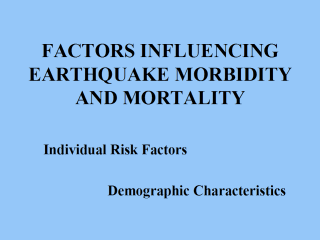 |
In earthquakes, people over 60
years of age are at increased risk for death and injury and have a death rate that can be
five times higher than that of the rest of the population (67). Children between 5
and 9 years of age, women, and the chronically ill also seem to be at an elevated risk for
injury and death (67). Lack of mobility to flee collapsing structures, inability to
withstand trauma, and exacerbation of underlying disease are factors that may contribute
to the vulnerability of these groups. Mortality distribution by age will also be affected
to a certain degree by the social attitudes and habits of different communities. For
example, in some societies young children sleep close to their mothers and may be more
easily protected by them. |
